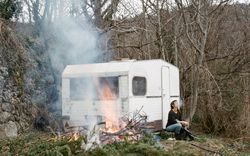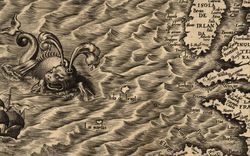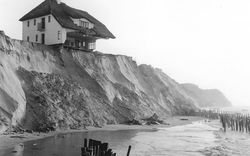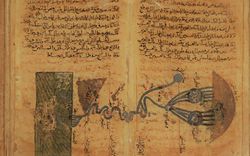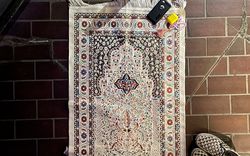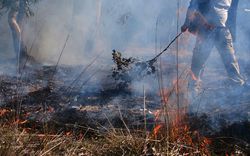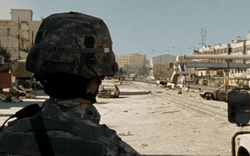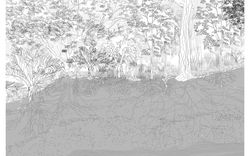Counter-Narratives of Care
Michaela Prunotto in dialogue with Loving Country. Photo essay by Vicky Shukuroglou.
“During that fire event (I was thinking about it today because I was on that road) there are still parts of [the road] which bear the scars of fallen trees because the bitumen was on fire. This is unprecedented. That is an incredibly hot fire.”1
-
My interview with Pascoe and Shukuroglou explored a broad question amidst the verbal backdrop of bushfires, ecological resilience, cultural burning, and designing for Country: that question being “How does the power of ‘presence’ shape architecture and place-making today?” See Bruce Pascoe, in Bruce Pascoe and Vicky Shukuroglou, interview by Michaela Prunotto, “MTalks – Igniting Presence – a Forum on Inflection Vol.8,” MPavilion, published December 14, 2021, https://mpavilion.org/program/igniting-presence-a-forum-on-inflection-vol-08/. ↩
When I spoke with Yuin, Bunurong, and Tasmanian writer Bruce Pascoe in December of 2021, he described settler-colonial infrastructure (“bitumen”) that had been ossified with the traces of a combusted Indigenous ecosystem during the 2019–2020 Black Summer bushfires. Pascoe went on to assert that this bushfire ecology of Australian town Mallacoota has been knocked off-kilter—enflamed to “unprecedented” temperatures—by its colonial timber logging industry. Pascoe’s remarks, driven by language of collision and contact, bear witness to the violence of settler colonial narratives which have come to shape Australia’s built environment: he articulates counter-narrative.
In Australia, colonial manifestations of dispossession are apparent in almost all facets of our built environment, from bitumen roads, to steel-framed apartment blocks, to webbed power lines. These concrete structures fuel settler colonial narratives: that is, narratives which camouflage the ongoing damages imposed by colonization through a monumental veneer of “progress.” My aim here is therefore to steer away from direct discussion—avoiding consolidation through critique—of settler colonial narratives. Instead, it seems more constructive to provide a platform for utterances of counter-narrative. Whereas hegemonic colonial narratives are frequently connected to rapidly expanding, profit-driven structures, counter-narrative emerges from a more omnipresent and sacred terrain: Aboriginal and Torres Strait Islander conceptions of Country.
Given that in Australia there is patchy documentation of pre-colonial placemaking, Traditional Owner land rights are frequently contested, and Indigenous Australian communities are often under-resourced: counter-narratives of Country become an important device for tangible and intangible “placemaking as resistance.”1 The term “counter” is applied throughout the social sciences to describe a space of resistance against hegemonic forces. Counter-narrative, in turn, refers to stories that arise through the words of those who have been historically marginalized. Tapping into thousands of years of oral storytelling, songlines, and yarning as methods of knowledge transfer, when First Nations voices are amplified through contemporary vectors of postcolonial journalism and progressive academic discourse, counter-narratives of Country can be popularized. Unfortunately, in the face of a right-wing government and its proponents, the same counter-narratives can also be polarizing.
Bruce Pascoe—acclaimed author of the perplexingly contentious Dark Emu (2014)2—has been sensationally described by journalist Kerry O’Brien as a “lighting rod” for the clash of narratives over pre- and post-colonial history in Australia and the part that racism plays in this story.3 In reflecting here on an interview I conducted with Bruce Pascoe and Vicky Shukuroglou, co-authors of Loving Country: A Guide to Sacred Australia (2020), I look to the role of their collaborative counter-narratives in figuring the presence of Country within settler colonial Australia, with a focus on deep dialogue, more-than-human care, and cultural burning lore.
-
Alexandra Pereira-Edwards, “Counter-Infrastructures: Place-making as Resistance,” Inflection 8, ed. Michaela Prunotto, Kate Donaldson and Manning McBride (Melbourne: Melbourne Books, 2021), 8-13. ↩
-
In academic discourse, anthropologist and linguist Peter Sutton and archaeologist Keryn Walshe wrote a book that forensically critiques Pascoe’s book Dark Emu. Their book is titled Farmers or Hunter-Gatherers? The Dark Emu Debate. Importantly, Pascoe identifies foremostly as an author of fiction, poetry, and non-fiction, rather than as an academic. Pascoe has also faced personal attacks that question his Indigenous Australian heritage by far-right politicians and media channels. ↩
-
Bruce Pascoe, interview by Kerry O’Brien, “A better future for all: Kerry O’Brien in conversation with Bruce Pascoe,” published October 12, 2020, https://www.youtube.com/watch?v=qX_1z1qNoa8. ↩
Deep Dialogue
“Am I speaking on behalf of someone else? If so, do they know that I am doing so and do I have their permission to share this information? If so, have I stuck to the scope of the permissions that have been granted or am I starting to misrepresent their voice by speculating on a topic I only know a particular aspect of?”1
-
Sarah Lynn Rees, “Blakitecture: Beyond acknowledgement and into action,” Architecture Australia 109, no.2 (2020): 66. ↩
Sarah Lynn Rees, a Palawa woman descending from the Plangermaireener and Trawlwoolway people of north-east Tasmania, suggests this kind of iterative questioning when grappling with decolonization or Indigenization in an architectural context. Sensitivity and self-reflexivity seem to be crucial to productive, positive action by non-Indigenous Australians. This is not to say that questioning should unravel to the point of effacement; Wailwan/Kamilaroi man and scholar Jefa Greenaway has commented on the tendency within non-Indigenous university architecture faculties of treading on “cultural eggshells,” that is, “inaction through fear of making a mistake.”1 The “moral paralysis” that occurs through white withdrawal from fields of intercultural engagement—being able to select which issues to engage with when it comes to architectural history—is a clear example of white privilege.2 Although my writing here is motivated by critiques of white stasis, it is nevertheless important to note authorial identity and limitations. As a white, first-generation migrant to Australia with partial Italian heritage, I note my naivety but also earnestness for social change when it comes to the politics of First Nations People in Australian architecture discourse and beyond. Through this writing about spatialized counter-narratives, my capacity for listening deeply to the stories of others is widened and in turn, can hopefully generate further dialogue for collective empathetic growth.
The Sarah Lynn Rees modus operandi of repeated questioning—as opposed to monologue—was taken to heart in my virtual interview with Bruce Pascoe and Vicky Shukuroglou, held in December 2021, wherein I posed short questions (on ecological resilience, designing for Country, Cultural Burning) to the speakers so my own presence receded. Beautifully intricate and candid stories told by Pascoe and Shukuroglou ensued.
An important characteristic of the interview format is that it can generate, or broaden, a deep dialogue. Ethnographer Deborah Bird Rose advocates for openness, and thus unpredictability, when it comes to structuring the ground of ethical dialogue. Since openness produces reflexivity, one’s own ground (in this case, the ground of the interviewer) becomes destabilized and subject to being surprised, challenged, and changed.3
Unfortunately, beyond architectural discourse and toward the general white Australian public, there remain those who aggressively trample Greenaway’s dialogical “cultural eggshells” as well as those who avoid them altogether by remaining firmly closed and monological. This brings us to the power of Pascoe’s oeuvre; that is, counter-narratives that have broached the Australian collective consciousness through their far-reaching ability to unsettle a settler colonial monologue and spark highly mediatized, albeit sometimes distressing, dialogue. The intentionality of this courageous approach was voiced emphatically by Pascoe in our interview: “We have to talk to people that we know aren’t going to agree with us. I think that is vital.”4
Despite Pascoe’s willingness to confront difficult conversations, he also collaborates with like-minded allies such as Shukuroglou. As a non-Indigenous Australian whose ancestors nevertheless carry stories of dispossession, Shukuroglou embraces an ethic of dialogical care in her understanding and love for Country. In Loving Country, she writes in the introduction about those First Nations People who verbally and informally shaped the book: “Through every community, people embraced discussion and appreciated being heard. They want their stories to be told, for country to be better understood and loved… Each person carries their own story.”5 In this way, Shukuroglou becomes instrumental as a counter-narrative bricoleur by collaging, interpreting, and transporting the stories of others to a wider audience through her own empathic voice.
-
Jefa Greenaway in “Decolonising Architectural Education,” a Melbourne Design Week panel talk moderated by Rochus Hinkel and Peter Raisbeck, 25 March 2022, https://www.youtube.com/watch?v=KhY3hbMSW8Q. ↩
-
Nancy L. Nelson cited in Kelly Greenop, “Taking my place / talking your place: race, research and indigenous architectural history,” in Speaking of Buildings: Oral History in Architectural Research, ed. Janina Gosseye, Naomi Stead, and Deborah van der Plaat (Belgium: Die Keure, 2013), 155-56. ↩
-
Deborah Bird Rose, “Indigenous ecologies and an ethic of connection,” in Global Ethics and Environment, ed. Nicholas Lowe (London, New York: Routledge 1999), 175. ↩
-
Pascoe, interview by Prunotto, “MTalks – Igniting Presence,” 2021. ↩
-
Vicky Shukuroglou, “Introduction,” in Bruce Pascoe and Vicky Shukuroglou, Loving Country: a guide to sacred Australia (Melbourne: Hardie Grant, 2020), ix. ↩
Figuring Country
“If we’re thinking about Country holistically, it’s not just land, it’s not just the sky, it’s not just the sea, it’s everything and every system that exists within that space, both tangible and intangible, with every aspect experiencing equity.”1
-
Sarah Lynn Rees, quoted in N’arweet Carolyn Briggs AM, Sarah Lynn Rees in conversation with Max Delany, “Ngargee Djeembana: On the materiality of public space and Country,” Artlink 41, no.2 (2021): 14. ↩
This quote, again by Sarah Lynn Rees, articulates a powerful counter-narrative to depict Country. In a settler colonial Australian context, we can conceptualize counter-narratives as self-determined channels through which Traditional Owners map their own conceptions of place. As the complex viewpoints of individuals are articulated, agentic (softly territorial) place-making occurs through mechanisms of language. It is important to note that descriptions of Country to non-Indigenous Australians inevitably rely on processes of linguistic translation, whether this be in a way that has occurred over generations or immediately. The limiting nature of this translation is best summarized by Bua Benjamin Mabo, a Meriam linguist, who notes that “Keriba gesep agiakar dikwarda keriba mir; The land actually gave birth to our language.”1 Here, language and land are portrayed as inextricably interconnected.
-
AIATSIS, “Living Languages,” https://aiatsis.gov.au/explore/living-languages. ↩
More-Than-Human Care
“She thought of the ground hugging echidna, the soil particles dotting its eyes, encrusting its moist nostrils, and distinctly scenting its body. Echidna’s perspective is of another world to hers—its horizons varied—its architecture imbued with subtlety of that place.”1
-
Vicky Shukuroglou and Bruce Pascoe, “WHOSE ARCHITECTURE,” Inflection 8, ed. Michaela Prunotto, Kate Donaldson and Manning McBride (Melbourne: Melbourne Books, 2021), 30-33. ↩
My interview with Pascoe and Shukuroglou stemmed from their contribution to Inflection Journal Vol.08, a student-run journal out of the Melbourne School of Design. Pascoe and Shukuroglou’s story for Inflection, titled “Whose Architecture,” is divided into two tender more-than-human parts: the first half follows a broken-quilled echidna, and the second introduces us to “a dingo with an injury.”1 There is a shift in location, pronoun, and authorial voice that occurs at the mid-point juncture, which both authors noted was an intentional and important disorientation device. In our interview, Shukuroglou went on to clarify that “dislocation, uncertainty, raising questions is part of the way I like to approach writing… dislocation is very much part of this land.”2
Pascoe and Shukuroglou approach writing about landscape and the more-than-human in a way that is exquisitely detail-oriented yet holistic and interconnected. This is representative of a broader ecological ethic that they apply in their everyday lives; Pascoe with his Black Duck Foods (a social and agricultural enterprise), and Shukuroglou with her Nillumbio biodiversity activist group (based in the Shire of Nillumbik). Both their sensitive actions and literary narratives nourish Country as a delicate ecosystem of equilibrium that requires respect and care. In Loving Country, this counter-narrative of care persists through the framing of a guidebook that offers an alternative way to travel and comprehend Australia via Indigenous narratives, with a broader intention to “foster communication and understanding between all peoples and Country.”3 Through the structuring of each chapter in the book as situated amongst culturally significant locations—the first chapter is titled “Gulaga & Biamanga,” the second “Namadgi,” and so on—Loving Country facilitates direct interactions with tangible places through temporally knit dialogue. Pascoe and Shukuroglou’s counter-narrative of care aligns with Lynn Rees’ description of Country as a harmonious system in which every aspect is “experiencing equity.” For indeed, Country is a terrain in which land, sea, earth, and sky come together not as resources to be contested, but as “vital place.”4
At one point in our interview, Shukuroglou speaks to an image that depicts dew drops on a spiderweb: the web has been built around barbed wire and has caught native grass seeds from panicum, which is an important food source for Indigenous people across large areas of the country for thousands of years.5 Although the circumscribing, aggressive material of barbed wire invokes colonial farming and anthropocentric meat consumption, in the same conversation Pascoe marvels at “all the little worlds, that cosmos of life, on the barbed wire fence.” He urges us: “if you look closely, you can see on one of the beads in the middle, the surface tension that joins the [spider] web.” Where territorial barbed wire asserts itself, a cosmos of Country prevails by way of close observation and poetic articulation. The micro-architecture of a spider and panicum grass seeds rouse up an incredibly humane but also more-than-human Country in our consciousness.
-
Sukuroglou and Pascoe, “WHOSE ARCHITECTURE,” 30-33. ↩
-
Shukuroglou, interview by Prunotto, “MTalks – Igniting Presence,” 2021. ↩
-
Pascoe and Shukuroglou, Loving Country. ↩
-
Libby Porter, “From an urban country to urban Country: confronting the cult of denial in Australian cities,” Australian Geographer 49, no.2 (2018): 244. ↩
-
Porter, “From an urban country to urban Country,” 244. ↩
Cultural Burning Lore
“People working on the farm go through Yuin lore. And part of that lore is fire. So every few months, every few weeks at the moment, we are practicing that lore. So Australians can be reassured that Aboriginal People are still practicing the old lore. There is stuff that we don’t know that we would like to know, but we have to concentrate on the positives. We know this, because we’ve been told by that old man that old lady, that this is how things used to work… It makes you smile and weep at the same time to see films of the old people burning and walking through (fire) in bare feet.”1
-
Pascoe, interview by Prunotto, “MTalks – Igniting Presence,” 2021. ↩
Perhaps one of the most moving aspects of the interview with Pascoe and Shukuroglou was their discussion of fire. Pascoe talked about his close encounter with the Black Summer bushfires of 2019-20, which—as conveyed by his introductory quote to this essay—was “incredibly hot” and scarily destructive. However, the co-authors also discussed their involvement with cool cultural burns. “Cultural burning” is defined by Wiradjuri man and scholar Michael-Shawn Fletcher as the First Nation Australian utilisation of low intensity fires which remove the accumulation of fine fuels such as leaves, twigs, or dry grass to promote new growth. It is a practice that is “intimate and reflexive to local settings” and performed for a range of reasons: spiritual and ritual, pragmatic and economic.1
On these cool cultural burns, Pascoe explains “We always say here, if you can’t walk through that fire with a pair of Blundstones, then it is too hot… if we can do that, then so can the animal. And we are burning for that animal.”2 Through the spoken transfer of knowledge Pascoe expresses again critical care for an interwoven ecology of people, animals, and landscape. Furthermore, this process of sharing stories and co-existing with the more-than-human occurs as a deeply spatial-temporal phenomenon. Just as “Whose Architecture” explores “the idea that we share homes – generation upon generation, beast upon beast,” there is also a transfer of knowledge and of counter-narrative that occurs through space and time across generations.3
Resilient Terrains
When understanding the indelible and positive contribution of Bruce Pascoe in communicating counter-narratives of Country—through prolific and popular writing, hands-on activism, and willingness for dialogue—it renders the criticism of his stories (which is frequently white, and either academicized or right-wing extremist) a little less important. Despite the details in his non-fiction texts that have generated impassioned and nuanced dialogue, it is evident that Pascoe remains unequivocally committed to facilitating positive social and ecological change. Resilience becomes an important embodiment of Pascoe and counter-narratives alike; the individual-with-voice defies adversity and intergenerational trauma to forge a productive space of resistance against settler colonial oppression. Fundamentally, Pascoe and Shukuroglou’s collaborative counter-narratives of Country are characterized by generous, critical care, and will work to transmit a spatialized (and positive) dialogue that flexes and expands within Australia over generations to come.

